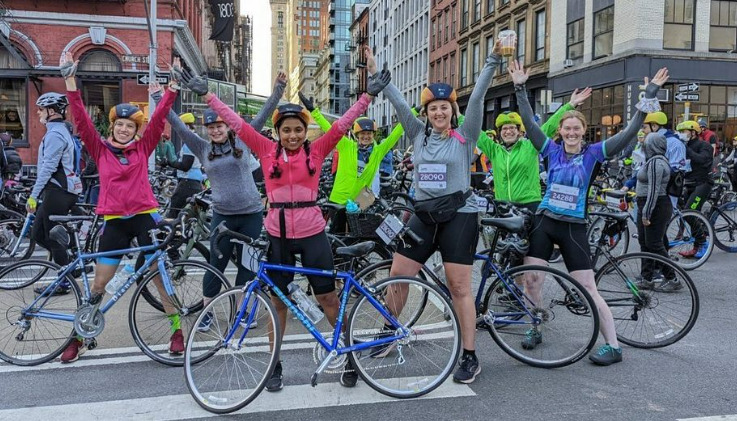By Meg Ausen
Long rides to the beach or up to Westchester are awesome summer NYC based rides. Upping the hours we’re in the sun also increases the possibility of overheating. We’ve probably all been there to some degree, but what can we do to avoid heat-related illness when biking? Below are some simple tips and advice on avoiding, recognizing, and treating both heat exhaustion and heat stroke. Peddle safe!
Avoiding Heat-Related Illness
According to several medical websites, ways to avoid heat-related illnesses include:
- Wear loosefitting, lightweight, light-colored clothing. Remember: long sleeves do not always mean you will be hotter. If you have lightweight, wicking material, it might keep your body cooler than clothing with less material that leaves more of your skin exposed.
- Avoid sunburn. Apply sun screen liberally (usually at least every two hours) and remember to apply it to places like your ears and your nose. Cycling caps also provide your face with some shade. Sunglasses are highly advised, too!
- DRINK FLUIDS!!! Do not wait until you are thirsty to drink – drink often. Mix it up – add some electrolytes to your water or throw in a sports drink that has electrolytes. We sweat out a lot of salt when we exercise, so electrolyte replenishment is a must. Drinks with large amounts of sugar can cause a greater loss of body fluid. Avoid alcohol! Avoid coffee/caffeine if your body has difficulty retaining electrolytes.
- Let your body acclimate to the heat – take breaks often in shaded areas (an ideal time to replenish fluids). Try to avoid doing all of your cycling during the high heat of the day.
Recognizing if you have Heat Exhaustion or Heat Stroke
Not sure if what you are experiencing is a heat-related illness? WE aren’t doctors, so it’s best to consult a medical professional in the case you aren’t feeling well, but here are some symptoms:
Heat Exhaustion
There are two types of heat exhaustion; the first is caused by water depletion and signs include excessive thirst, weakness, headache, and loss of consciousness. The second is caused by salt depletion and signs include nausea and vomiting, muscle crams, and dizziness. Heat exhaustion isn’t as serious as heat stroke, but it is still serious. Without proper care, heat exhaustion can progress into heat stroke. Symptoms include:
- Confusion
- Dark-colored urine
- Dizziness
- Fainting
- Fatigue
- Headache
- Muscle or abdominal cramps
- Nausea, vomiting, or diarrhea
- Pale skin
- Profuse sweating
- Rapid Heartbeat
Heat Stroke
Heat stroke is the most serious form of heat-related illness and is considered a medical emergency. If you suspect that you or someone else has heat stroke, call 911 immediately and administer first aid until paramedics arrive. Heat stroke can kill or cause damage to the brain and other internal organs. It often occurs as a progression from milder heat-related illnesses such as heat cramps, heat induced fainting, and heat exhaustion. However, it can occur even if there are no previous signs of heat-related illness. Symptoms include:
- One of the core symptoms includes a core body temperature above 105 degrees Fahrenheit, although fainting may also be the first sign.
- Throbbing headache
- Dizziness and light-headedness
- Lack of sweating despite the heat
- Red, hot, and dry skin
- Muscle weakness or cramps
- Nausea and vomiting
- Rapid heartbeat, which may be either strong or weak
- Rapid, shallow breathing
- Behavioral changes such as confusion, disorientation, or staggering
- Seizures
- Unconsciousness
Treatment
If you or anyone, or anyone else, has symptoms of heat exhaustion, it’s essential to immediately get out of the heat and rest, ideally in an air-conditioned space. Or, if outside, seek out the nearest cool and shady spot. Other recommendations include: drink lots of fluids (avoid caffeine and alcohol); remove any tight or unnecessary clothing; take a cool shower or bath; apply other cooling methods like fans or wet/ice towels.
If you, or anyone else, has been exposed to heat stroke, call 911 immediately or transport the person to a hospital (but not by bike!!). Any delay of treatment makes the complications worse and can prove fatal. While waiting for paramedics to arrive, initiate first aid. Move the person to an air-conditioned space, or if outside to a cool and shady area. Remove any unnecessary/tight fitting clothing. If possible, take the person’s core body temperature and initiate first aid to cool it to 101 or 102 degrees Fahrenheit. If no thermometer is available, don’t hesitate to administer first aid. Steps include: fanning air over the individual while wetting their skin with water; applying ice packs to the individual’s armpits, groin, neck, and back (these areas are rich with blood vessels that are close to the skin and cooling them may reduce body temperature; immerse the individual in a shower or tub of cool water, or an ice bath.
If you have been exposed to heat-related illness, it is best to avoid high temperatures during the following week or so since your body will likely be more sensitive to the heat. Talk to your doctor about when to resume normal activities.
Again, WE are not medical professionals, so we advise that if you suspect that you or someone around you is experiencing a heat related illness to seek medical help immediately. Biking (or any athletic activity outdoors) during the summer provides some of the best fun you can have in New York City. Approach the heat right and stay healthy – if you know are susceptible to heat-related illnesses there is no shame in taking it easy! If that’s the case, beat the heat at a movie and treat yourself to some popcorn 🙂

